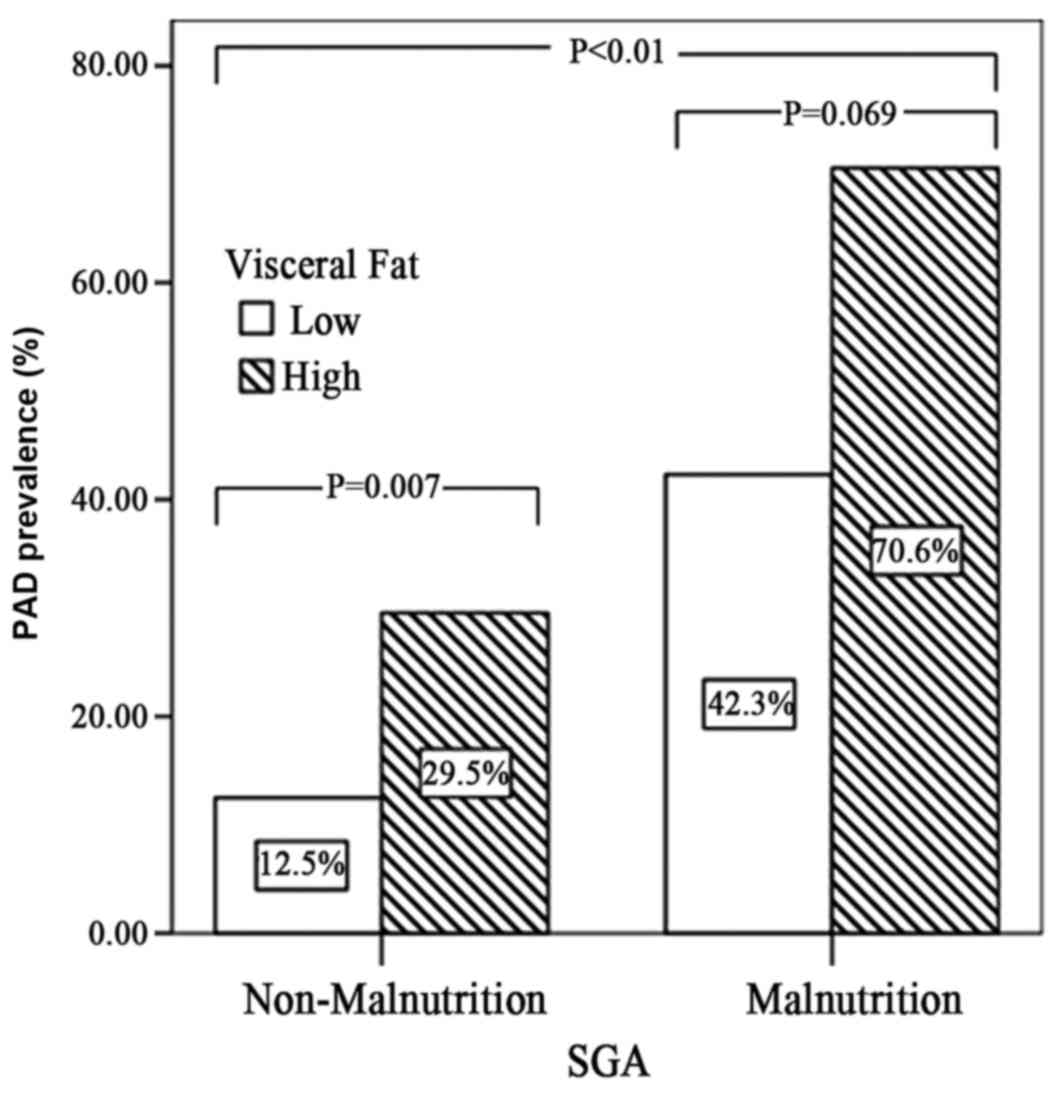|
1
|
Liu JH, Lin HH, Yang YF, Liu YL, Kuo HL,
Wang IK, Chou CY and Huang CC: Subclinical peripheral artery
disease in patients undergoing peritoneal dialysis: Risk factors
and outcome. Perit Dial Int. 29:64–71. 2009.PubMed/NCBI
|
|
2
|
Chen SC, Su HM, Chang JM, Liu WC, Tsai JC,
Tsai YC, Lin MY, Hwang SJ and Chen HC: Increasing prevalence of
peripheral artery occlusive disease in hemodialysis patients: A
2-year follow-up. Am J Med Sci. 343:440–445. 2012. View Article : Google Scholar : PubMed/NCBI
|
|
3
|
Tian SL, Tian XK, Han QF, Axelsson J and
Wang T: Presence of peripheral arterial disease predicts loss of
residual renal function in incident CAPD patients. Perit Dial Int.
32:67–72. 2012. View Article : Google Scholar : PubMed/NCBI
|
|
4
|
Jimenez ZN, Pereira BJ, Romão JE Jr,
Makida SC, Abensur H, Moyses RM and Elias RM: Ankle-brachial index:
A simple way to predict mortality among patients on hemodialysis-a
prospective study. PLoS One. 7:e422902012. View Article : Google Scholar : PubMed/NCBI
|
|
5
|
Otsubo S, Kitamura M, Wakaume T, Yajima A,
Ishihara M, Takasaki M, Ueda S, Sugimoto H, Otsubo K, Kimata N, et
al: Association of peripheral artery disease and long-term
mortality in hemodialysis patients. Int Urol Nephrol. 44:569–573.
2012. View Article : Google Scholar : PubMed/NCBI
|
|
6
|
Tian SL, Tian XK, Han QF and Wang T:
Peripheral arterial disease predicts overall and cardiovascular
mortality in peritoneal dialysis patients. Ren Fail. 34:1010–1014.
2012. View Article : Google Scholar : PubMed/NCBI
|
|
7
|
Matsuzawa R, Aoyama N and Yoshida A:
Clinical characteristics of patients on hemodialysis with
peripheral arterial disease. Angiology. 66:911–917. 2015.
View Article : Google Scholar : PubMed/NCBI
|
|
8
|
Locatelli F, Fouque D, Heimburger O,
Drüeke TB, Cannata-Andía JB, Hörl WH and Ritz E: Nutritional status
in dialysis patients: A European consensus. Nephrol Dial
Transplant. 17:563–572. 2002. View Article : Google Scholar : PubMed/NCBI
|
|
9
|
Papagianni A, Kokolina E, Kalovoulos M,
Vainas A, Dimitriadis C and Memmos D: Carotid atherosclerosis is
associated with inflammation, malnutrition and intercellular
adhesion molecule-1 in patients on continuous ambulatory peritoneal
dialysis. Nephrol Dial Transplant. 19:1258–1263. 2004. View Article : Google Scholar : PubMed/NCBI
|
|
10
|
Oka RK and Alley HF: Differences in
nutrition status by body mass index in patients with peripheral
artery disease. J Vasc Nurs. 30:77–87. 2012. View Article : Google Scholar : PubMed/NCBI
|
|
11
|
Pecoits-Filho R, Lindholm B and Stenvinkel
P: The malnutrition, inflammation, and atherosclerosis (MIA)
syndrome-the heart of the matter. Nephrol Dial Transplant. 17 Suppl
11:S28–S31. 2002. View Article : Google Scholar
|
|
12
|
Choi HY, Lee JE, Han SH, Yoo TH, Kim BS,
Park HC, Kang SW, Choi KH, Ha SK, Lee HY and Han DS: Association of
inflammation and protein-energy wasting with endothelial
dysfunction in peritoneal dialysis patients. Nephrol Dial
Tranplant. 25:1266–1271. 2010. View Article : Google Scholar
|
|
13
|
Zoccali C: The obesity epidemics in ESRD:
From wasting to waist? Nephrol Dial Transplant. 24:376–380. 2009.
View Article : Google Scholar : PubMed/NCBI
|
|
14
|
Honda H, Qureshi AR, Axelsson J,
Heimburger O, Suliman ME, Barany P, Stenvinkel P and Lindholm B:
Obese sarcopenia in patients with end-stage renal disease is
associated with inflammation and increased mortality. Am J Clin
Nutr. 86:633–638. 2007. View Article : Google Scholar : PubMed/NCBI
|
|
15
|
Feigelson HS, Criqui MH, Fronek A, Langer
RD and Molgaard CA: Screening for peripheral arterial disease: The
sensitivity, specificity, and predictive value of noninvasive tests
in a defined population. Am J Epidemiol. 140:526–534. 1994.
View Article : Google Scholar : PubMed/NCBI
|
|
16
|
Young GA, Kopple JD, Lindholm B, Vonesh
EF, De Vecchi A, Scalamogna A, Castelnova C, Oreopoulos DG,
Anderson GH, Bergstrom J, et al: Nutritional assessment of
continuous ambulatory peritoneal dialysis patients: An
international study. Am J Kidney Dis. 17:462–471. 1991. View Article : Google Scholar : PubMed/NCBI
|
|
17
|
Lee JW, Lee HR, Shim JY, Im JA, Kim SH,
Choi H and Lee DC: Viscerally obese women with normal body weight
have greater brachial-ankle pulse wave velocity than nonviscerally
obese women with excessive body weight. Clin Endocrinol (Oxf).
66:572–578. 2007.PubMed/NCBI
|
|
18
|
Postorino M, Marino C, Tripepi G and
Zoccali C: CREDIT (Calabria Registry of Dialysis and
Transplantation) Working Group: Abdominal obesity and all-cause and
cardiovascular mortality in end-stage renal disease. J Am Coll
Cardiol. 53:1265–1272. 2009. View Article : Google Scholar : PubMed/NCBI
|
|
19
|
Fantuzzi G and Mazzone T: Adipose tissue
and atherosclerosis: Exploring the connection. Arterioscler Thromb
Vasc Biol. 27:996–1003. 2007. View Article : Google Scholar : PubMed/NCBI
|
|
20
|
Mafra D, Guebre-Egziabher F and Fouque D:
Body mass index, muscle and fat in chronic kidney disease:
Questions about survival. Nephrol Dial Transplant. 23:2461–2466.
2008. View Article : Google Scholar : PubMed/NCBI
|
|
21
|
Berg AH and Scherer PE: Adipose tissue,
inflammation, and cardiovascular disease. Circ Res. 96:939–949.
2005. View Article : Google Scholar : PubMed/NCBI
|
|
22
|
Axelsson J, Qureshi Rashid A, Suliman ME,
Honda H, Pecoits-Filho R, Heimbürger O, Lindholm B, Cederholm T and
Stenvinkel P: Truncal fat mass as a contributor to inflammation in
end-stage renal disease. Am J Clin Nutr. 80:1222–1229. 2004.
View Article : Google Scholar : PubMed/NCBI
|
|
23
|
Kuang L and Wong ND: Abstract 38: HDL
cholesterol, inflammation and peripheral arterial disease in U.S.
adults. Circulation. 129 Suppl 1:A382014.
|















